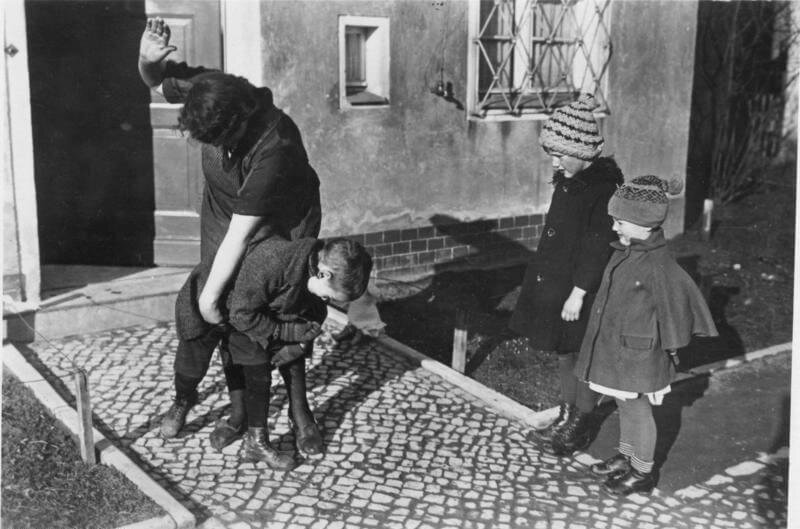In the United States, corporal punishment continues to be legal in nineteen states. In Latin America and the Caribbean, one in two children suffers from physical punishment.
The United States’ health insurance and benefits company, Cigna, defines corporal punishment as “the intentional use of physical force to cause pain or bodily discomfort as punishment for unacceptable behavior.” These punishments can be carried out with different instruments, such as reeds, boards up to 60 centimeters, or palm-of-hand. Corporal punishment has been used many years in the classroom when students do not show “acceptable” behavior in the teachers’ eyes or challenge authority figures. It is generally practiced in primary education but can be found from preschool to high school.
Corporal punishment in education was practiced in the days of the Roman Empire, the Middle Ages, and the 19th century. Around 1800, teachers began to justify these sanctions under the law and doctrine called in loco parentis. This doctrine regarded teachers as authority figures with the same legal rights as parents to discipline and punish children if they did not adhere to the rules established for behavior in the school environment.
Which countries still apply corporal punishment in schools?
Thanks to the appearance of the Declaration of Human Rights, corporal punishment began to be banned in various areas, such as in the justice system or military training centers. However, a place where its elimination has not been accomplished, and these punishments are not condemned, is the schools.
The United States
The New York Times published an article in 2018 explaining that these kinds of physical punishments are still legal in public schools in nineteen states and private schools in 48 states. The article reports that states like Tennessee and Louisiana have brought the issue to light by changing their laws in recent years to protect children with disabilities, the most vulnerable in these states. Many U.S. school districts have voted to ban this practice, as families and teacher communities have demanded changes and bans on such punishments. However, even if the school districts have banned them, they remain technically legal in 48 U.S. states.
Africa
UNICEF conducted several surveys in 23 countries in Africa between 2005-2013 related to corporal punishment in homes and school institutions. The study found that, in countries such as Botswana, 92% of students had received some form of corporal punishment. Another study in The Gambia reported that these punishments were used in 70% of the country’s institutions. In Uganda, they found that 79% of students were afraid or insecure to attend classes because of the corporal punishment in classrooms. Today, some countries that have legally banned these practices are Benin, Cape Verde, Congo, Republic of Kenya, South Sudan, Togo, and Tunisia (UNICEF, 2015). Many of the laws and efforts to eradicate these punishments have been delayed by political problems often faced in these countries, so aid and attention to the issue often occur through international initiatives.
Latin America and the Caribbean
According to UNICEF, in Latin America and the Caribbean, one in two children suffers corporal punishment. Although ten countries in this territory have already legally banned such sanctions, the organization warns that cultural change is also required to make this behavior toward children utterly unacceptable in any area. Venezuela, Costa Rica, and Uruguay were the first countries to take positions on the issue and prohibit these practices at home and in educational institutions, followed by Brazil, Bolivia, Honduras, Nicaragua, and Argentina in more recent years. In Mexico, in 2019, the Senate passed a law with 114 unanimous votes prohibiting corporal punishment for children in public and private institutions.
However, the most alarming situation is in the Caribbean, where “these practices are not condemned, but are legitimized in schools and the home,” says UNICEF Regional Protection Adviser Nadine Perrault in an article for the BBC. Countries practicing corporal punishment include Jamaica, Guyana, and Barbados, but Haiti and Belize explicitly prohibit school institutions’ practice.
>
“Globally, only 9% of children live in countries where they are protected by law from adult punitive assaults.”
Let’s put an end to corporal punishment
People who argue in favor of these punishments say that they are quick and effective ways to get the student to act in the desired manner and that some parents prefer small punishments rather than a suspension. However, corporal discipline is not effective in the long term; it can have psychological consequences on the victims’ mental health. UNICEF’s analysis notes that children exposed to severe corporal punishment are 2.4 times less likely to develop sufficiently in early childhood. Exposure to violent discipline increases the child’s likelihood of exhibiting aggressive behavior towards other children by 1.6 times.
An article published in Psychology Today says corporal punishment results from feelings of frustration and helplessness on parents or teachers. The author invites teachers at any grade level to educate through words, rather than violent actions, as this is a more effective way to achieve children’s healthy development. “If a child verbalizes their feelings, they will learn to delay their actions,” declares Anny Katan. It increases the child’s ability to put words into their feelings, which will decrease and regulate their tension and increase their self-awareness, leading them to practice conscious decision-making.
Why is it essential to eradicate such practices in the 21st century? Many studies have shown, as mentioned above, that corporal punishment is counterproductive to getting the little ones’ attention and maintaining the teacher as a respected authority figure. One of the strategies recommended by an article in the Digital Journal of Psychology and Mind is to work on socio-emotional skills. These are defined as “the most basic and complex skills;” it is more productive to develop them and work on them during childhood. They will guide children as adults to regulate their emotions and communicate effectively. Examples of these skills include resilience, self-knowledge, tenacity, social awareness, collaboration, empathy, and self-management.
UNESCO’s International Education Day (January 24) celebrated the “role that education plays in peace and development.” In the 21st century, however, disciplinary corporal punishments continue to be applied in schools worldwide. Yet, children worldwide have the right to access education in a learning environment free from violence of all kinds. Let us remember that the development of children is in our hands and that it depends on us to mold them well to write the future when their turn comes.
Translation by Daniel Wetta.
This article from Observatory of the Institute for the Future of Education may be shared under the terms of the license CC BY-NC-SA 4.0 
)
)


)